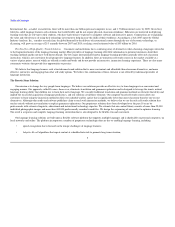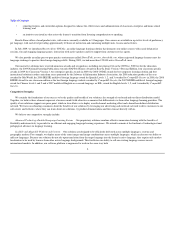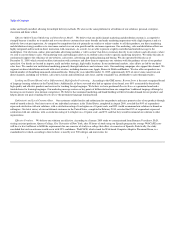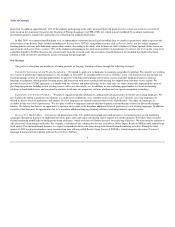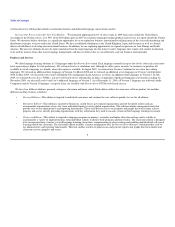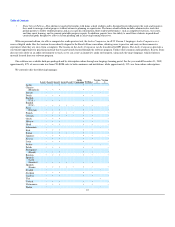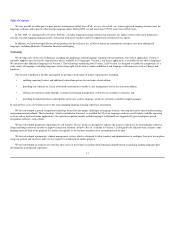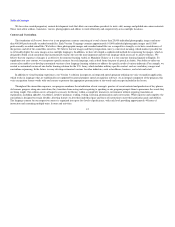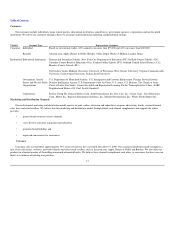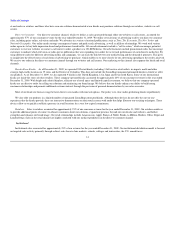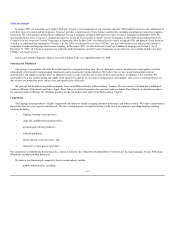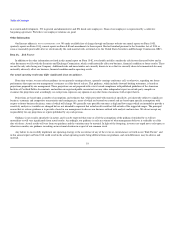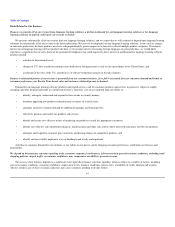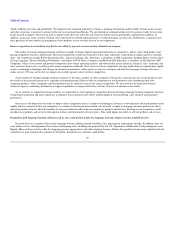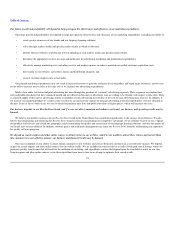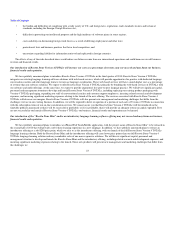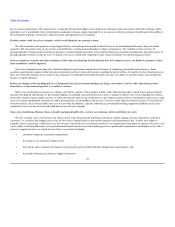Rosetta Stone 2009 Annual Report Download - page 17
Download and view the complete annual report
Please find page 17 of the 2009 Rosetta Stone annual report below. You can navigate through the pages in the report by either clicking on the pages listed below, or by using the keyword search tool below to find specific information within the annual report.
Table of Contents
and federal government agencies; corporations; and not-for-profit organizations. Regional sales managers are responsible for sales of our solutions in their
territories and supervise account managers who are responsible for maintaining our customer base.
Educational Institutions. These customers include primary and secondary schools and represented approximately 44% of our institutional sales for the
year ended December 31, 2009. In our experience, colleges, universities and schools frequently rely on references from peer institutions and an official
request-for-proposal, or RFP, process when selecting a vendor. We generate sales leads from sources such as visiting potential customer sites to provide
briefings on our solutions and the industry, interacting with attendees at trade shows and conferences, responding to inbound calls based on recommendations
from existing customers and monitoring and responding to RFPs.
Federal Government Agencies and Armed Forces, Not-for-Profit. These customers include governmental agencies and armed forces and organizations
developing workforces to serve non-native speaking populations, offering literacy programs and preparing members for overseas missions and accounted for
approximately 25% of our institutional sales for the year ended December 31, 2009. Many customers in this market license our products through online
subscriptions. We have recently been adding sales representatives to this group to allow greater focus by senior sales executives on expanding some of our
key relationships.
Corporations. We promote interest in this market with onsite visits, trade show and seminar attendance, speaking engagements and direct mailings.
Many of our customers in the market prefer online subscription delivery. Corporations represented 12% of our institutional revenue for the year ended
December 31, 2009.
Home Schools. We promote interest in this market through advertising in publications focused on home schooling, attending local trade shows and
seminars and direct mailings. Home school sales accounted for approximately 19% of our institutional revenue for the year ended December 31, 2009.
International
International sales accounted for approximately 8% of our revenue for the year ended December 31, 2009. In the near term, our international activity is
primarily focused on successfully growing our business in the United Kingdom, Germany, South Korea and Japan, where we are utilizing many of the same
direct-to-consumer and channel strategies that we developed in the domestic market. We opened our United Kingdom office in 2005, our Japan office in
2007, and our Korean office in 2009. Over time, we believe that we will be able to develop a similar business model in other markets in Europe, Asia and
Latin America.
Product Development
Our product portfolio is a result of significant investment in product development over 16 years. Our product development focuses on both software and
content development. Our development efforts include both creating new solutions and adding new languages to existing solutions. Our development team
has specific expertise in speech recognition, interface design, immersion learning and instructional design.
In 2006, we licensed speech recognition technology for language learning from the Regents of the University of Colorado. We subsequently hired several
of the original developers of this technology to begin building our expertise in speech recognition. Since 2006, we have made significant improvements to the
original technology. We believe that this technology and expertise distinguishes us from other companies in our industry.
15


